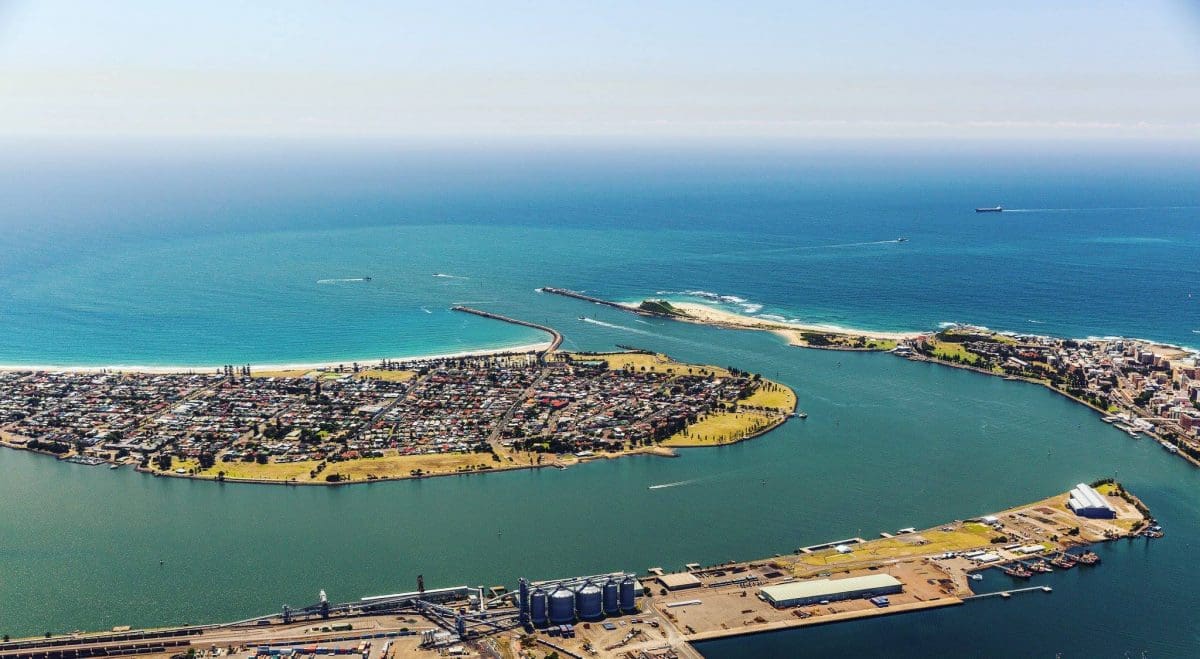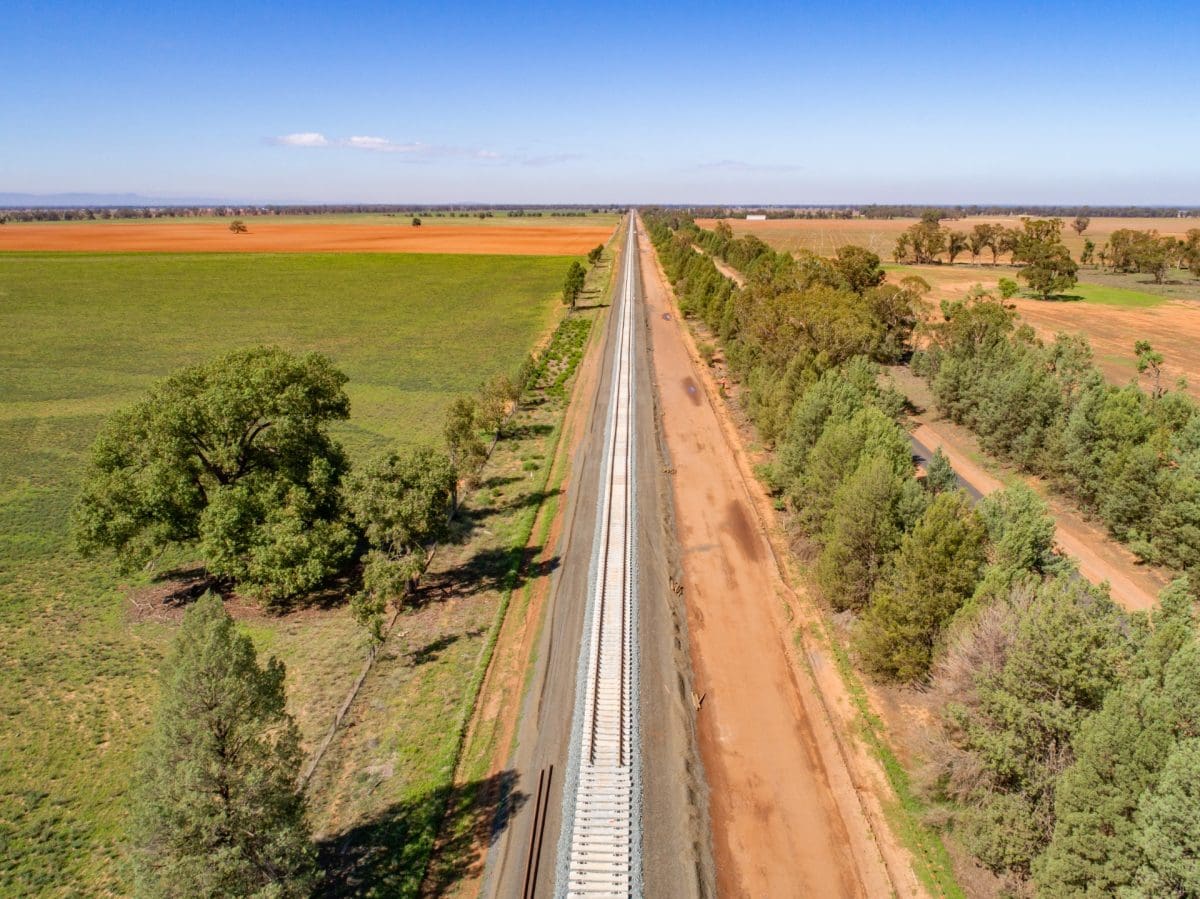
Newcastle’s two grain terminals have been receiving interstate grain throughout the drought, and are on track to be exporting again by December. Photo: Newcastle Agri Terminal
RAIL and port operators in New South Wales are preparing for a massive grain export task of close to 3 million tonnes (Mt) in wheat alone as the state gears up for its first full harvest in four years.
Weather permitting, the season’s first grain trains are expected to start loading in the wider Moree district late next month, with the first export vessels due to load wheat at Newcastle in November.
Return to normal
The upcoming harvest will see a return of the normal flow of grain from paddocks to export terminals, and reverse the supply chain which was turned on its head by three years of drought..
It saw grain arriving by sea into Brisbane, Newcastle and Port Kembla, mostly from South Australia and Western Australia, for dispersal to domestic consumers.
The biggest rail operators in NSW are Pacific National (PN) and Southern Shorthaul Rail (SSR), and they brought many thousands of tonnes of grain from SA and Victoria, and a little from WA also, into NSW and southern Queensland in the largest internal drought freight task ever seen.
“We’ve been in a business that’s been averaging six runs a week from SA into NSW and six or seven from Victoria for drought feeding,” PN agricultural manager Hugh Cox said.
Since drought hit, many PN grain wagons have been parked in regional NSW and Victoria, and they are all ready to return to operation.
“We could be running up to 120 services a week.”
“When it comes to rollingstock, we’re in a good position, and we’ve got the labour.”
Mr Cox said PN had been training additional staff over recent months in the lead-up to the harvest task.
“I think it will be the most grain you’ve seen go to port ever.”
Industry is forecasting that the Australian wheat harvest, now under way in northern regions, will produce more than 28 million tonnes (Mt) Australia-wide. NSW production is likely to exceed 9Mt, more than four times the drought-hit production in each 2018 and 2019.
It creates the unusual prospect of NSW growing more wheat than Western Australia, which typically produces the most wheat of any Australian state.
However, small domestic markets in WA and SA mean they are both expected to export more wheat than NSW, because NSW has the biggest wheat use by far of any Australian state (table 1).
| Production | Exports | Domestic use | |
| Qld | 1,429,000 | 305,000 | 1,907,000 |
| NSW | 9,416,000 | 2,845,000 | 3,857,000 |
| Vic | 3,410,000 | 1,865,000 | 1,789,000 |
| SA | 4,849,000 | 3,720,000 | 612,000 |
| WA | 9,089,000 | 7,580,000 | 848,000 |
| TOTAL | 28,193,000 | 16,315,000 | 9,013,000 |
Table 1: Estimated wheat production, exports and domestic use for 2020-21 (Oct-Sep). Source: Lachstock Consulting
Competitive rates
Grain railed during the drought has built confidence in the rail’s ability to compete with road and even sea freight, and set some new benchmarks for itself.
“We’ve competed with shipping out of SA and Victoria, and we’re in a position to drive some value back to the growers.
“You will see benefits of that this season.”
Also favouring the rail haul task this year will be big volumes heading from inland NSW to Newcastle, and the heaviest trains ever to run on the Walgett-Narrabri line.
It can easily carry up to 1mt of wheat alone, and a line upgrade done during the drought have increased its axle load to 23 tonnes from 21t.
“That’s an extra 8t per wagon, and on a 40-wagon train, that’s 320t.”
Grain Trade Australia location differentials (LDs) are used to help calculate grain prices at port, and for the farthest points on the rail network, that can equate to a discount from the port price of $60-$70/t.
Mr Cox believes heavier and more grain trains carrying up to 4000t can put an extra $10-$15/t in growers’ pockets.
“What we can achieve on rail might mean the growers get $265/t for their wheat instead of $250.”
Flow from north
Despite earlier hopes that Queensland would have a big export surplus of new-crop grain to ship, a patchy growing season is likely to limit its bulk shipments, and see most of Queensland’s wheat and all of its barley consumed locally.
However, small or part-cargoes of wheat, bulk exports of chickpeas, and plenty of containers of chickpeas and wheat are expected out of Brisbane and Central Queensland (CQ) ports in coming months.
Eastern Australia’s export program will hit its straps in Newcastle in November, when Newcastle Agri Terminal (NAT) and GrainCorp Carrington both look likely to start loading vessels.
“We’re pretty much booked out for the first few months, and we expect we’ll get a ship mid to late November,” NAT supply chain manager Chris Treloar said.
Newcastle is the natural terminal port (NTP) for NSW grain from Dubbo to the Queensland border.
Growers across the region will fill their silos and probably warehouse some grain to supply the local and Queensland feed market, and replenish their own stocks.
However, much of the region’s grain from will head to Newcastle for export, and trucks will also play their part.
“The task will be so massive there’ll need to be road as well.”
With no rail link from the Moree district into Queensland, road is already carrying early harvested crops north to consumers and container packers on the Darling and Western Downs.
Early chickpeas and wheat are also filtering on to the Downs from CQ.
Southern
Weather permitting, harvest will be in full swing in central and south-western NSW in November, with rail paths to Port Kembla likely to be busy with wheat from December, and canola not far behind.
Manildra Group’s Shoalhaven Starches plant has used Canadian wheat to get through the drought, and the last cargo in a string which started last June is now discharging at Port Kembla.
The Shoalhaven facility is expected to start receiving new-crop NSW wheat by rail in December, and the GrainCorp and Qube-owned Quattro terminals at Port Kembla expected to do the same with grain bound for export.
In Victoria, the rail and shipping task is expected to be going by December at Emerald Grain’s Melbourne terminal, and GrainCorp Geelong, with some business from other traders operating at public berths.
GrainCorp Portland as the point of export for eastern Australia’s latest crops will start shipping in January.
Moree-Narrabri closure looms
Looking into next year, northern NSW works for ARTC’s Inland Rail project will close the Moree-Narrabri North line from Penny’s Road, Bellata north from 1 April to 31 October, and from Penny’s Road south in 2022.
The line services what is arguably Australia’s biggest cluster of grain-on-rail users, including Arrow Commodities, CHS Broadbent, GrainCorp, LDC and Manildra Group.
“It is going to put a lot of pressure on the network,” Mr Cox said.
“We’ll be focused on getting stock out of there ASAP.”
Mr Cox said this would involve working in with the busy coal path from north-west NSW to Newcastle.
“We’ll be looking at sites to load 24/7.”
An ARTC spokesperson said there needed to be a balance struck between delivering the Narrabri-to-North Star section on time and within budget, and taking into account the needs of the line’s users.
“With these considerations in mind, ARTC has developed a construction schedule allowing works on the Narrabri North to Moree section to be undertaken minimising impact on key harvest and offtake periods as much as possible.”

The Parkes-Narromine section of Inland Rail has opened this month. Photo: ARTC
ARTC said it continued to work with all stakeholders including grain growers, traders and train operators using the existing network, to assess the impact to their operations and appropriate mitigations.
ARTC said it was also delivering a complementary investments along the rail supply chain from north-west NSW to the Port of Newcastle.
It said these would deliver immediate loading and connectivity benefits, and ultimately reduced transport costs, to farmers and industry.
“Alongside Inland Rail, this will mean significant long-term benefits for the regional grain supply chain.”
In the grain space, Fletcher International out of Dubbo, PN, Qube Agri and SSR among those running their own trains in NSW have voiced concerns about access rates charged to use rail, which on some lines are payable to ARTC.
Mr Cox said Inland Rail would ultimately bring increased efficiencies through enabling the network to carry bigger wagons and longer train.
“The bigger the service, the cheaper the rate.”
Grain Central: Get our free daily cropping news straight to your inbox – Click here

HAVE YOUR SAY